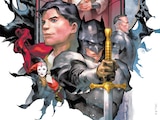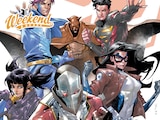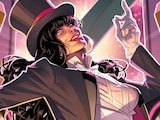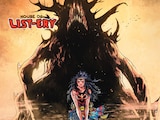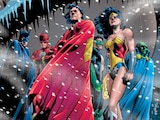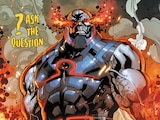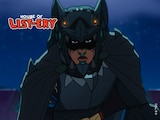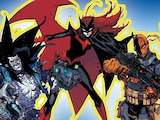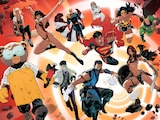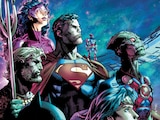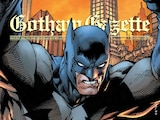In recent years, new queer heroes have emerged all throughout the DC Universe. Spanning across worlds, characters such as Dreamer, Kaldur’ahm and Jon Kent plant flags of justice and equality for everyone of all stripes. Yet there is one corner of the DCU where queer representation has thrived the longest, making it DC’s most visible LGBTQIA+ hub—Gotham City.
Queerness in the world of comic books and particularly Batman has been an ongoing topic of conversation for more than half of the character’s existence. From the moral panic surrounding comic books and the 1954 Senate hearings, to the publication of the now-discredited book Seduction of the Innocent—in which psychologist Frederic Wertham alleged that reading Batman comics would make children gay—to the camp sensibilities of the 1960s Batman TV series, the notion of queer coding and homosexual undertones within Batman have long been prevalent. For decades, it was a negative connotation, perceiving the psychology of Batman as something which for much of the 20th century was incorrectly viewed as abnormal.
In other words, it was an extremely difficult time to be gay, with much of society’s attitudes dictated by a much less evolved sense of morality and overall lack of understanding about sexuality. And it was over this period that the idea of Gotham City took shape. Things were extremely difficult in Gotham as well, only here it was driven by authority figures who weren’t just misguided, but outright corrupt. These are whom the Dark Knight and his allies fought against. They were meant to be vile. As understanding and acceptance increased in the world, it made the villains of Gotham City that much more evil to resist and outright reject that progress and show that they were willing to use their imperfect city’s biases against its champions.

The most explicit example of this is in the award-winning story “Half a Life,” a five-part Gotham Central story by Greg Rucka and Michael Lark. Queer detective Renee Montoya is outed to her police squadron in an attempt to ruin her reputation and frame her for murder by the villain Two-Face. During the story, Montoya is confronted by her cop partner, her brother and her captain—Maggie Sawyer, who is herself a lesbian. Everyone demands that Renee either confide in them or follow their suggestions for an easier life, which largely means denying who she is. The whole thing leads her down a spiraling crisis of faith until she’s found and trained by Victor Sage a.k.a. the Question, who aids her into becoming a better, truer version of herself as his successor.
Consequently, Renee’s closetedness contrasts with another queer woman from Gotham: Kate Kane a.k.a. the second Batwoman. Unlike Renee, Kate—who was in a relationship with her roommate at the military academy—refused to deny her identity when the academy informed her that she could only continue her training if she disavowed her queerness. Discharged from the military, Kate returned to her Colonel father Jacob, who expressed his pride in her and would go on to help her operations as Batwoman.

It's hard to think of a more important character for LGBTQIA+ representation than Kate Kane, who was co-created by Gotham Central’s Rucka and who along with illustrator J.H. Williams III did the lion’s share of establishing her queer identity during their acclaimed run on Detective Comics. While certainly not the DCU’s first queer character, Kate was the first out lesbian to anchor her own comic when she took the lead of Detective in 2009. DC had made a statement by making Kate the hero of their flagship title—LGBTQIA+ heroes were an integral part of the DCU. They were here and they were here to stay.
Since then, more queer characters have popped up in Gotham with each passing year. With so many LGBTQIA+ characters, often their stories have become entwined, and many times they help each other grow into their better, more altruistic selves. Harley Quinn and Poison Ivy—two of Batman’s most prominent female adversaries—regularly ranked as Gotham’s most dangerous villains until they grew closer to one another. When Ivy found Harley nearly killed by the Joker, the two started a genuine friendship that would develop into something more over the years.
In 2016’s Batman #41-#43, Ivy’s taken over the world, enslaving mankind as a means to save the environment. Batman, in a last-ditch effort to bring Ivy to reason, highlights that this would inevitably change Harley—knowing full well how Ivy feels about her. Since this event, Harley and Ivy have grown not only closer as romantic partners but more altruistic as anti-heroes, less intent on destruction and more intent on making the world better with each other, however they see fit.

Queerness isn’t solely represented by women in Gotham, of course. Recently, Tim Drake accepted his bisexuality in the three-part story, “Sum of Our Parts.” Written by Meghan Fitzmartin and drawn by Belén Ortega, this game-changing tale finds Tim breaking up with his longtime girlfriend Stephanie Brown and reuniting with an old friend, Bernard Dowd. While saving Bernard from some assailants, Tim hears Bernard confessing to having a crush on him and realizes his reciprocal feelings were something he was denying in himself for a very long time. Defined since his first appearance by a desire to help Batman and others, Tim had long suppressed his own needs for the greater good. In “Sum of Our Parts,” we see not only a realization of his identity, but an embracing of it.
While these characters represent the evolution of their identities through self-realization, newer queer characters further represent the complexities that come with those intersectional relationships. Dr. Victoria October first appears in Detective Comics #948 as the foremost expert in Post-Human Bioweaponry. A trans physician, it’s referenced that Batman had known her for quite some time and sent a letter of encouragement when she came out.

More prolific, however, is the character of Alysia Yeoh in the pages of Batgirl. Created by Gail Simone, Alysia comes out to Barbara as trans in issue #19. Over time, she would meet and marry her partner Jo Munoz, and their storyline concerning starting a family would continue into Hope Larson’s later run on the title. Alysia deals with being misgendered by their doctor, mulling over artificial insemination vs. sperm donors and even has a crisis of faith in her relationship, briefly returning to stay with Barbara until her confidence in her relationship with Jo is revived. Not many superhero comics can claim to present the trials and difficulties in starting a family presented with these specific obstacles, and certainly not in the worst city in comics.
With each year, the conversation about ideal representation grows. The hopes that the characters presented will be meaningful and accurate to the readers’ personal experiences advances with every storyline. A city as large and diverse as Gotham provides all sorts of opportunity for queer representation—as heroes, as villains and as ordinary, everyday people. While queer representation in the DCU certainly doesn’t begin and end with Gotham, it can’t be denied that it’s thanks to Batman’s dark home that their world looks much brighter and more hopeful than what has come before.
Donovan Morgan Grant writes about comics, graphic novels and superhero history for DC.com. Follow him on Twitter at @donoDMG1.
NOTE: The views and opinions expressed in this feature are solely those of Donovan Morgan Grant and do not necessarily reflect those of DC or Warner Bros. Discovery, nor should they be read as confirmation or denial of future DC plans.

